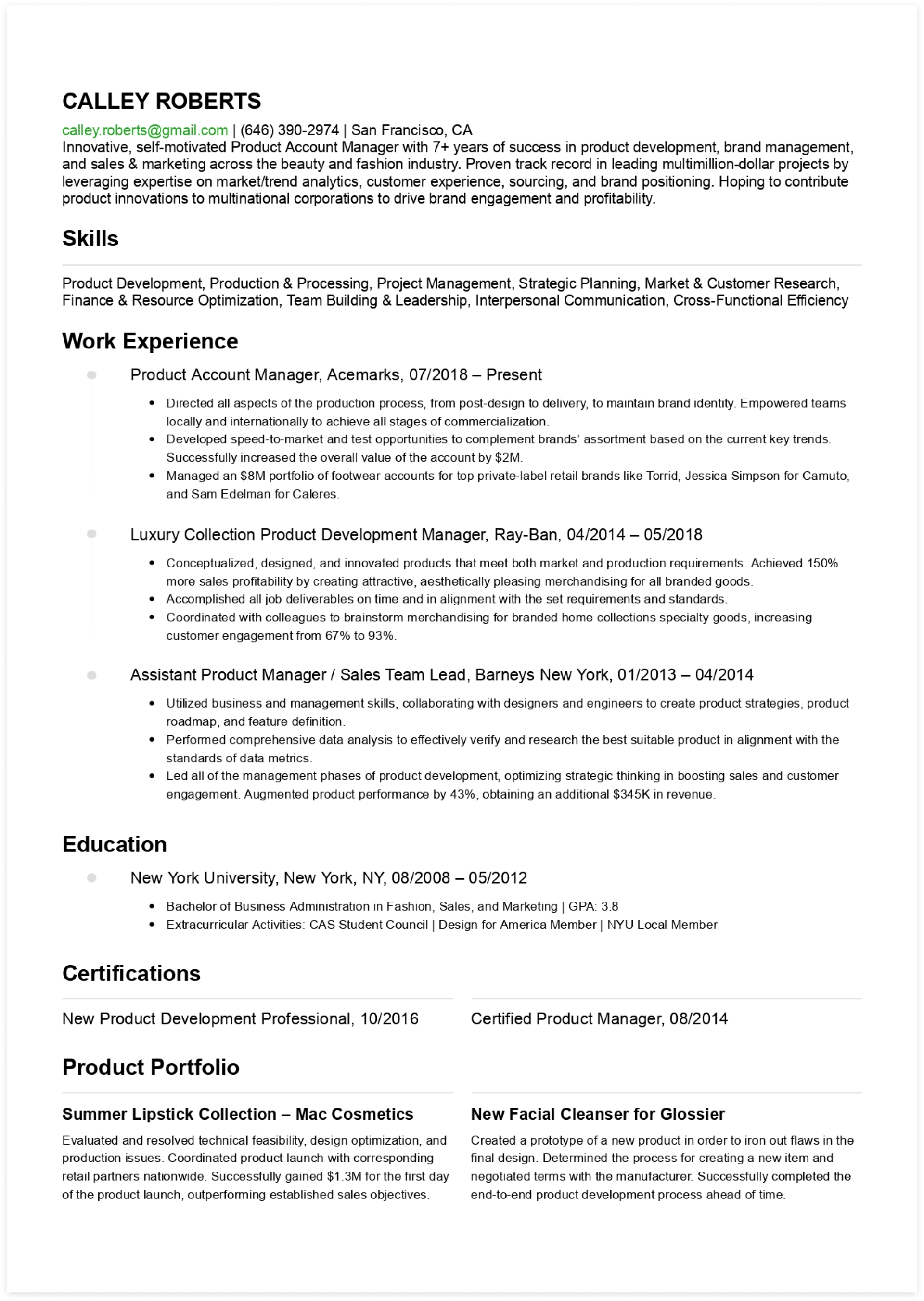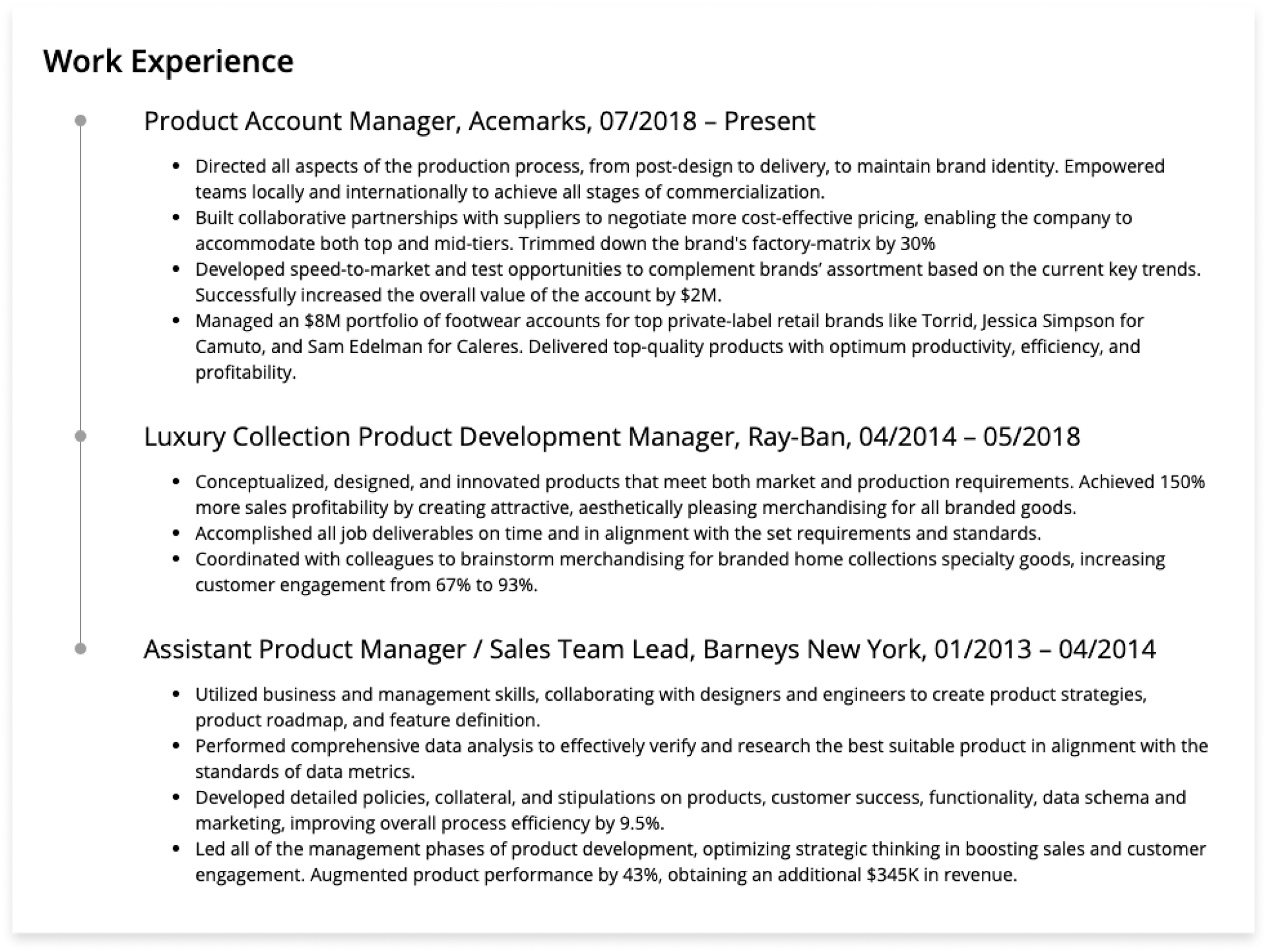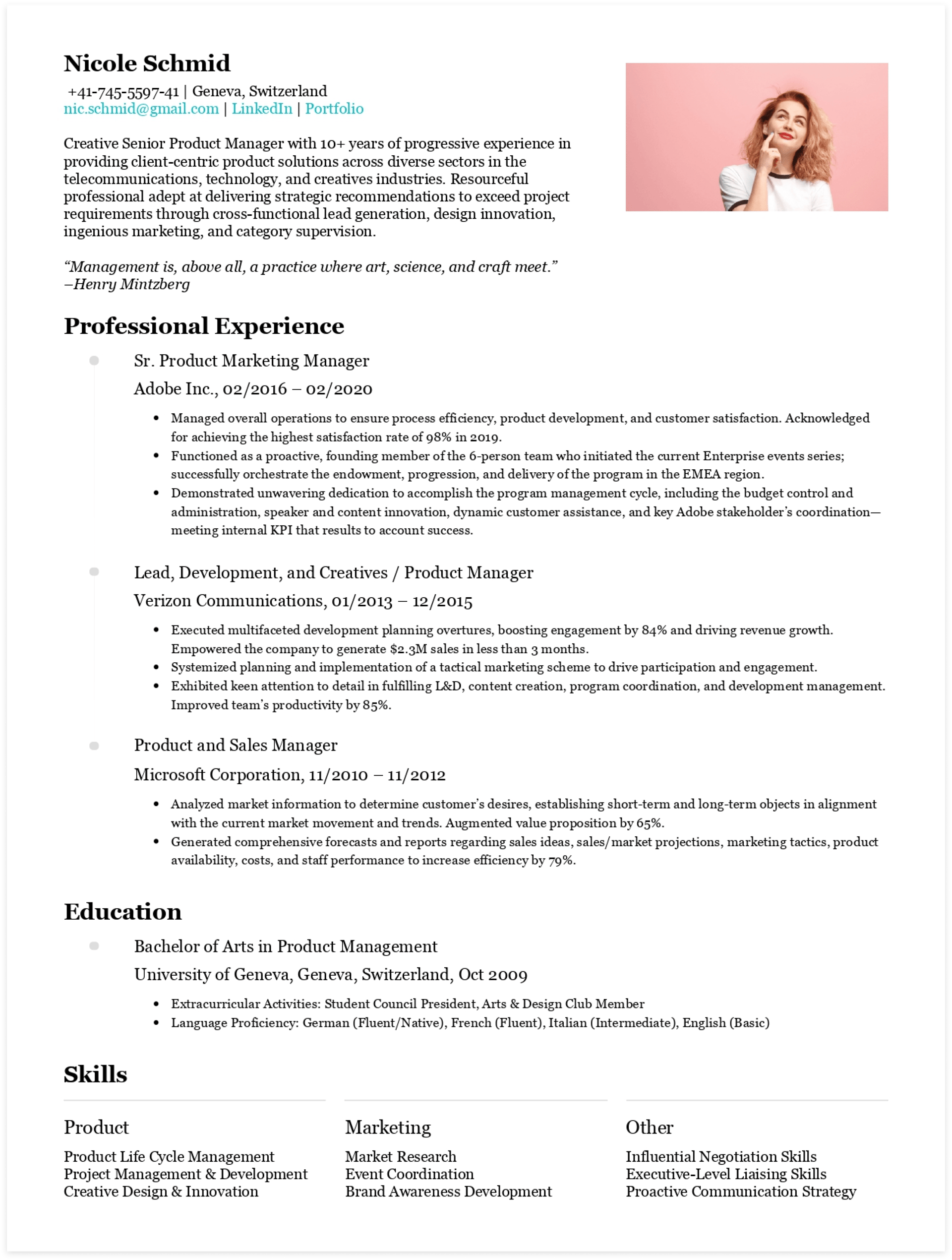Product Managers: Resume Examples, Formats & Tips
As a product manager, you build products for your customers. You figure out what users need, and you create a solution to solve their needs.
As a job seeker, you build resumes for potential employers. Similarly, you need to figure out what employers want before making a resume that fits.
For product managers, there is no right background, school or hard skills. Different products often require different skill sets, which means that you need to tailor your resume for different PM roles.
Act like a product manager and ask yourself: is this what they want?
Overview
What should be on a product manager’s resume?
How to choose the right resume format?
What should be on a product manager’s resume?

1. Contact information
Make sure you have your contact information on top of the page. Here’s a quick checklist:
- Full name
- Email address
- Phone number
- LinkedIn profile
- Personal website (optional but recommended)
- Other social media profiles (optional, only if they’re professional)
2. Resume summary/objective
A resume summary highlights your top achievements and skills; a resume objective describes your career goals. Nowadays it’s best to integrate them and reflect both where you have been and where you are going in this section.
Quick tips:
- Concise: If you have specific numbers such as revenue growth or conversion rate, share it. If you can narrow down your area of interests, do so. Be as specific as possible.
- Short: Stick to 2 to 4 sentences. The point of a summary is to let HR quickly grasp who you are.
- Relevant: Speak to the job description. Don’t talk about how great you are in copywriting when you’re applying for a product manager. Scan through your past experiences and pick one that best matches the requirements.
- Write your resume objective/summary AFTER you’ve finished the rest of your resume. Look at your past experiences and ask yourself, “Who is this person?” “What is worth highlighting?”

3. Work experience
It takes a lot of time and effort to write a great work description. You want to show your best talents without boasting.
A common flaw: you mentioned job duties but not achievements or results. That’s as if saying “I’ve taken a course in Statistics.” Great, but did you get a C or an A? A better way is to mark achievements, preferably in numbers. For example, “increased product sales by 30% in a year” looks much more impressive than “responsible for product sales”.
If you have enough space, try to give more context or methodologies behind the results. Here’s a simple formula for work experience descriptions by Laszlo Bock, former Google SVP of People Operations:
Job description formula
Accomplished [X] as measured by [Y] by doing [Z]
By giving context, employers can get a better understanding of what the numbers mean and how you reach them. It also shows that you’re not boasting. Even if you cannot include them in your resume due to space limitations, make sure you’re ready to talk about them in your cover letter and interview.
Finally, avoid too much technical jargon. While your final interviewer will likely understand PM jargons, you first want HRs to understand your strengths.

4. Education
Beside basic information such as university name, location, years in school, majors and minors, you can include more details that explain what you’ve learned and accomplished in school. Here are some ideas:
- Relevant coursework
- GPA (only if it’s impressive)
- Awards or honors
- Student clubs or organizations
- Leadership roles
With that said, it’s better to stick to the basics if you graduated more than 3 years ago or if your academic experience is irrelevant to the PM role.

5. Skills
Dumping a bunch of words in the skills section shows that you’re not actually good at any of them. Make sure you are selective when listing your skills.
How to choose the right resume skills?
- Match the role: Look closely at the job description and highlight keywords. Are you experienced in any one of them? Make sure you put those skills on top of the skills section.
- Balance hard and soft skills: Product managers need both hard and soft skills. Popular hard skills include strategy, UX, coding, marketing, and data analytics. Popular soft skills include communication, leadership, time management, problem solving, and analytical thinking.
- Prepare evidence: You don’t need to include evidence in this section, but make sure you’re able to prove your skills with evidence from other sections on your resume. For example, if one of your past experiences includes “led a team of 14 to accomplish…”, you’re ready to put leadership and teamwork in the skills section.

6. Certifications & Awards
Certifications are not required, but they show that you have fundamental knowledge in the product field, and that you’re willing to take time to invest in yourself. There are lots of online courses in product management available, such as AIPMM Certified Product Manager Credentials, Udemy Product Management 101, and Digital Product Management by EdX and Boston University.
If you have a strong certification that speaks to the position, consider writing it in your resume summary, such as “PMI Agile Certified Practitioner with 5 years experience”.

7. Other experience
Product management is a competitive field. You want to use all kinds of approaches to stand out.
Do some research on the company. Are they involved in any conferences, publications or groups? Have you done anything that might spark their interest? For example, if you have a side project that dealt with a similar issue they’re tackling, share it. If you’ve attended an event held by them, name it. If you don’t have enough space, talk about them in your cover letter.

Further reading: The Cover Letter to Land Your Dream Job:5 Basic Paragraphs & 10 Tips (Free Templates)
How to choose the right resume format?
1. Order
A quick overview of 3 common resume formats:
Resume formats
- Chronological / Reverse-chronological resume: A chronological resume lists the most recent experience first and then backward through time. It’s the most common and straightforward format because HRs can see your most timely experience, often the highest achievements, first.
- Functional resume: A functional resume categorizes work experiences by professional skills instead of time. This is usually for career changers and those who have large gaps between each job since dates are absent.
- Hybrid resume: Obviously, a hybrid resume combines the elements of chronological resume and functional resume. Skills and achievements can be highlighted in an individual section, but work experiences are still listed in a chronological order.
Of all the options above, a chronological format is the best choice as long as you don’t have large gaps between jobs, especially for a field like product management that changes rapidly over time. A hybrid resume is also acceptable if you want some flexibility.
2. Column
If you’re not sure whether your resume will be read by an ATS (Applicant Tracking System), stick to a traditional one-column format. Two-columns will often lead to distortions by most ATS systems.
If you’re sure a human will read your resume, two-columns are usually more reader-friendly and visually attractive. Try moving shorter sections such as contact information, resume summary and skills to the left column.
3. Design
Does the product or the brand highly value aesthetics? If so, tailor your resume to speak to its style. Use design softwares such as Photoshop, Illustrator or Canva, or use customizable resume builders to help. (e.g. CakeResume)
Even if the company doesn’t value visual creativity as much, you still want your resume to look appealing. Try resume builders such as CakeResume to make formatting less painful, or look for a suitable template to change from.
4. Font
Use a professional font such as Arial, Calibri, Helvetica and Times New Roman. More modern fonts are also acceptable if you’re applying for an innovative startup, but make sure it’s readable.
Also, use no more than 2 font types and no more than 2 colors other than black and white. Finally, make sure the font size and spacing are comfortable and easy to read.
Ready to build your resume? Use our resume builder to quickly and easily build a stunning resume for free!
Product manager resume examples & templates (Downloadable!)

Like the design? Use CakeResume's free resume builder to easily make yourself a stunning resume.
Check out more resume examples on CakeResume!
3 bonus tips for product managers
- Be selective about what you put in your resume. How? Firstly, by speaking to the job description. Secondly, by speaking to the product. Skills needed across different products often vary. In fact, most PMs tend to work on one type or a limited set of product types. Talk about the similarities between their product and the products you’ve worked on. For example, if it’s a highly technical product, focus more on your technical skills and less on your marketing skills.
- Build a portfolio website. Compared to engineers and designers, the works of product managers are difficult to communicate, especially within the limited space of a resume. Hence, having a portfolio ready saves time for both the employer and yourself. Your portfolio is also a product - think about what employers would like to see. Finally, remember to put the link into your resume.
Further reading: What to Include in a Portfolio Resume? 3 Tips to Build a Professional Portfolio for Interview
- Proofread! Typos and grammar errors make HRs question your professional skills and reliability. Use a grammar checker or ask a friend to double check for you.
Ready to build your resume? Use our resume builder to quickly and easily build a stunning resume for free!
More Career and Recruitment Resources

Storytelling for social change, inclusive UX designs and gender equity light up my heart. Find me on LinkedIn.






